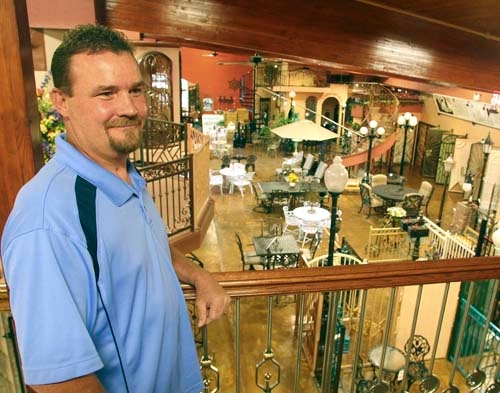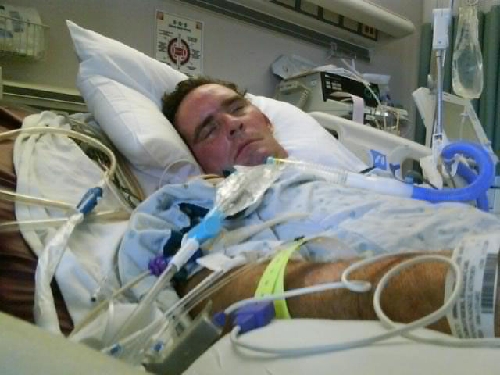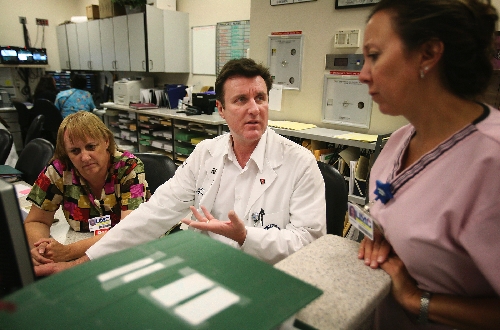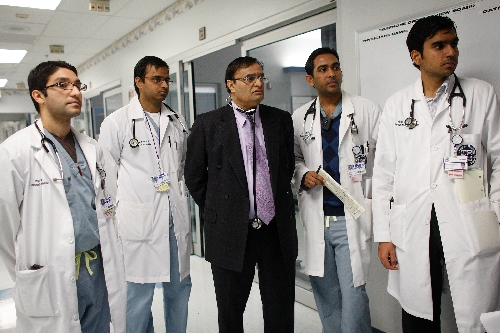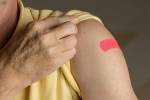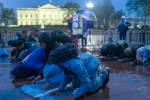Patient wins battle with H1N1
Dallas Carothers' left foot awkwardly slapped the floor Tuesday as he made his way across the Artistic Iron Works showroom. He clumsily gripped a pen in an almost-closed right fist.
A reddish, circular scar covered part of his neck.
And a huge grin spread across his face.
"I won the war," the salesman said as he stood in the store near downtown, nearly dropping his pen as he removed it from his right hand with his left so he could engage in a not-so-firm handshake.
For three months, beginning last November, the 38-year-old Carothers and an around-the-clock medical team did battle with the H1N1 flu virus that kept attacking his vital organs as he lay in a coma at University Medical Center.
A tracheostomy allowed a ventilator to drive air through a tube into his windpipe, delivering oxygen directly into lungs that bacteria had begun to rot.
He had to be chemically paralyzed because the pain from the therapies was so excruciating that there was a chance his self-protective thrashing could undo the treatment saving his life.
Nourishment was provided through a feeding tube inserted into his abdomen.
That Carothers won the war with the virus -- the medical bill for his treatment was $1.6 million -- even surprised his two principal physicians, Dr. R.D. Prabhu and Dr. Michael Casey, who told his wife, Sharri, more than once to prepare for her husband's death.
Today, Carothers is basically good to go, despite nerve and muscle damage from being bedridden for a long period of time. That has caused drop foot syndrome and weakness in the fingers of his right hand.
Now, though, he is trying to sell more than the wrought iron security gates, doors, fencing, patio furniture and railings that have made his employer a fixture in Las Vegas for 30 years.
"I want people to get vaccinated for H1N1," he said. "I'd hate to see anyone go through what I've been through."
Carothers, who was a muscular and energetic 205 pounds when he entered the hospital and a frail and limping 145 when he left, said his response to last year's government warnings about a frightening new flu strain that threatened to be a deadly global pandemic "was pretty much like that of most younger people."
"I didn't think it could affect me, because I was as healthy as a horse," he said. "Most people who really got hurt in the past by the flu were older. It was really a surprise when I got out of my coma and found out what got me."
Surprise. If there's one word that sums up both the entrance of the 2009 H1N1 virus onto the world scene as well as the effects of its transmission through populations, "surprise" probably qualifies better than most.
It was a distressing surprise last year when the novel strain of the H1N1 virus was detected in Mexico. It had genetic components of an H1N1 virus that killed up to 100 million people worldwide in 1918. And it was far more than a pleasant surprise when it turned out not to be anywhere near as virulent as scientists initially feared.
In fact, the CDC estimates the H1N1 virus, which basically elbowed seasonal flu viruses out of the way in the last year, was responsible for around 13,000 deaths in the United States, far below the usual estimated 35,000 deaths a year from the seasonal flu.
"We didn't know what it would do," said Jeffrey Dimond, a spokesman with the Centers for Disease Control and Prevention. "We planned for the worst and hoped for the best. We dodged a bullet."
In Las Vegas, H1N1 claimed the lives of 40 people from April 2009 until April 2010, compared to what Dr. John Middaugh of the Southern Nevada Health District said is "the usual 80 to 100 a year from the seasonal flu."
Also surprising, as Carothers found out, was who suffered the most from this flu strain: often the middle aged and young.
Around 9,500 people between the ages of 18 and 64 lost their lives to the virus nationwide, Dimond said, along with fewer than 1,500 children. Less than 2,000 were 65 and older.
"It hit populations that aren't used to having many fatalities from the flu," Dimond said. "With the seasonal flu, most people who die or get really sick are over 65."
Of the 40 people who died in Las Vegas from the H1N1 virus, only four were 64 years of age or older.
Only 66 of the nearly 3,800 H1N1 cases in Clark County involved people over 65.
Statewide only 1.7 percent of the 8,101 lab-confirmed cases involved the elderly. Incomplete state records show four deaths from the virus.
There were 400 hospitalizations in Southern Nevada, 458 statewide, and less than 10 percent involved seniors.
Why such a dramatic change?
"The working hypothesis is that people got exposed 30 or 40 years ago to a circulating virus that was similar and they received immunity from past exposure," Middaugh said. "People less than 60 had no pre-existing immunity."
As many as 80 million Americans got protection from the virus with a vaccine that the CDC hurried into production, but millions of people were still exposed to the virus.
"We know that it spread widely," Middaugh said. "And there's no question that millions became infected with the virus. But no one knows why it affected people minimally or that people had no symptoms. We have to be grateful that so many people were so lucky."
Carothers is just lucky to be alive.
About a week before he showed up in UMC's emergency room barely able to breathe, he thought he simply had a cold.
But his condition worsened enough to where he stayed home from work for a couple days and he went to a Quick Care. A doctor there thought he had a mild virus.
Prabhu, a pulmonologist, said X-rays would show Carothers already had pneumonia in one lung by the time he came to the emergency room. It wasn't until weeks into his treatment that tests confirmed he had H1N1.
"Here was a guy who was generally very healthy who never got sick, and three to six hours after he got to the hospital the pneumonia spread and involved both lungs," Prabhu said. "His lungs were all filled with water. He rapidly deteriorated in front of our eyes. He had complication after complication."
Anti-viral medications and antibiotics didn't appear to be slowing down the damage wrought by the virus. He was placed in an induced coma so he wouldn't need as much oxygen to survive.
Still, Carothers' lungs collapsed.
Trauma surgeon Casey, reacting to a call for help, surgically inserted two tubes into Carothers' chest to capture the air escaping from his lungs so they could be reinflated.
Melody Carothers wrote about that frantic emergency surgery in a journal she kept about her son's experience:
"Dr. Casey's team went throwing instructions in four directions at once literally! Poke two holes in his chest! Add this medicine here! Up the oxygen to this! PRAY! Yes, they even include that. It is pretty amazing to watch what doctors can do."
Casey recalled that it wasn't long before there was another serious complication.
"He also threw a blood clot in the lung," the doctor said. "He wasn't expected to survive that."
Carothers was placed on blood thinner for the clot, and soon his blood pressure dropped dangerously low.
His kidneys failed and he had to be placed on dialysis.
"I was working on four H1N1 cases then, and two of the people died," Casey said. "One of the reasons Mr. Carothers made it was that Dr. Prabhu realized the severity of this case so quickly."
It wasn't until two weeks before her husband was released from the hospital in February that Sharri Carothers knew he was going to live.
"So many times they said he probably wasn't going to make it," she said. "But then he got stronger and they brought him out of the coma and paralysis and he had to learn to talk and move and walk again. Physical therapy really helped him."
As he sat on patio furniture inside the Artistic Iron Works showroom, Carothers recalled that doctors said the fact that he was in excellent physical shape before his bout with H1N1 had much to do with his pulling through.
"It would have been a lot easier, though, to get the shot," he said.
According to the health district's Middaugh, only about 18 percent of those who could get vaccinated for the virus in Nevada did so. In some states, almost 40 percent of those eligible for the vaccine received it.
"In a way, it's a little like playing Russian Roulette with your life," Middaugh said.
The health district will continue to give free H1N1 vaccinations until the end of this month. Then next fall, the H1N1 vaccination will be included in a seasonal flu shot that affords protection against three strains of flu.
The physical toll that a flu virus places on people isn't the only concern that a vaccination can take care of, said Danita Cohen, a spokeswoman for UMC.
"It's a lot cheaper to get a shot," she said.
Even as her son lay in a hospital bed, Melody Carothers worried about the cost of his care. In her journal, she wrote:
"Is anyone curious about what this is costing? ... The doctors have been so busy saving his life they haven't had time to talk about the money! Yesterday I spoke with the UMC finance department -- they were very sweet -- and was told that hospital to date is now $790,000,000! .... Nope there is no insurance. The small business he (Dallas) works for dropped the policy September 1st trying to save jobs. We're gonna send the bills to the White House and see if we qualify for a bailout!"
Cohen said the Carothers family has been able to make some small payments on the bill, and hospital officials continue to see if his care can be covered by government Medicaid or disability programs.
Whatever can't be covered will be passed on to county taxpayers.
"A simple shot can protect you from a lot of problems," Dallas Carothers said.
Contact reporter Paul Harasim at
pharasim@reviewjournal.com or 702-387-2908.



